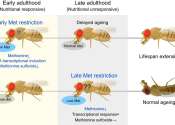Nematocera (includes Eudiptera)
Brachycera
True flies are insects of the order Diptera (Greek: di = two, and pteron = wing), possessing a single pair of wings on the mesothorax and a pair of halteres, derived from the hind wings, on the metathorax.
The presence of a single pair of wings distinguishes true flies from other insects with "fly" in their name, such as mayflies, dragonflies, damselflies, stoneflies, whiteflies, fireflies, alderflies, dobsonflies, snakeflies, sawflies, caddisflies, butterflies or scorpionflies. Some true flies have become secondarily wingless, especially in the superfamily Hippoboscoidea, or among those that are inquilines in social insect colonies.
Diptera is a large order, containing an estimated 240,000 species of mosquitos, gnats, midges and others, although under half of these (about 120,000 species) have been described. It is one of the major insect orders both in terms of ecological and human (medical and economic) importance. The Diptera, in particular the mosquitoes (Culicidae), are of great importance as disease transmitters, acting as vectors for malaria, dengue, West Nile virus, yellow fever, encephalitis and other infectious diseases.









